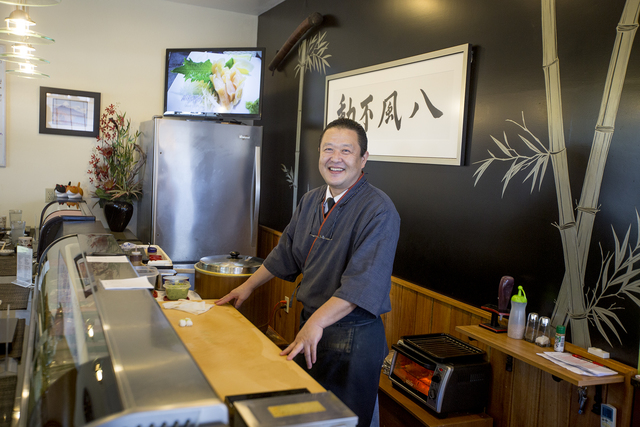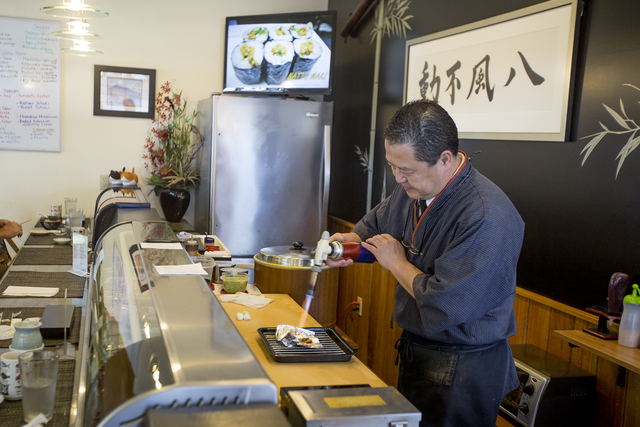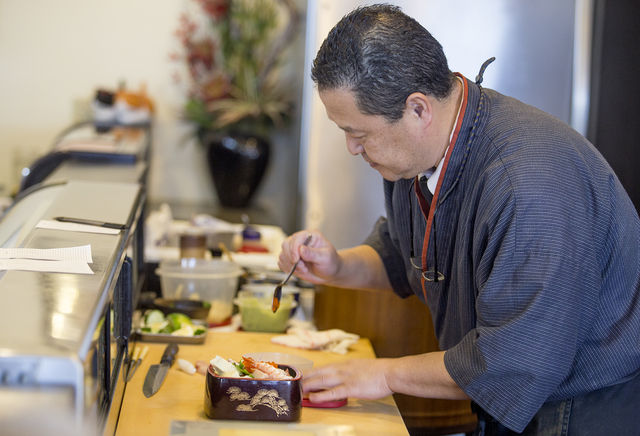Sushi restaurant’s popularity grows by leaps and bounds
A conversation with Mitsuru Igarashi, chef and owner of Takenoko Sushi at Manono Street Marketplace, is in many respects straightforward. Igarashi’s wife Pam translates on occasion as the 54-year-old chef describes his decades-long sushi career: how he started as a teenage dishwasher in Yokohama, working his way up the training ladder and eventually moving to the United States.
Hard work laid the foundation, but it’s Igarashi’s extra effort that has led to the success of his newest venture.
He wakes up before dawn twice a week to go to the Hilo airport for a 5 a.m. delivery pickup. The delivery comes from the Tsukiji Market, the largest wholesale fish market in the world. It’s in Tokyo.
The Tokyo delivery is Igarashi’s way of maintaining the highest quality possible in his sushi, and of ensuring that he’ll always have the fish he wants to serve on his menu, like bluefin tuna. Friends at the market vet the fish before it’s shipped off to Hilo. Uni comes from Hokkaido. Oysters from Seattle. Abalone from Kona.
During a recent Friday lunch, Igarashi chatted with a pair of customers in Japanese as he began preparing nigiri for another couple who had scored a coveted seat after a cancellation. A toaster oven dinged. Igarashi removed a slab of unagi and scored it with a small blowtorch before slicing the eel, flipping it easily onto a small rice base, painting the nigiri with a bit of sauce, and placing the sushi directly on his customer’s plate.
This all happened very quickly, in practiced, fluid motion.
Igarashi was 16 years old when he first began training in Yokohama. After he’d put in his dishwashing hours, he was allowed to wash the rice. Next, to clean up the fish.
He moved on to cooking rice. Years later, he was finally allowed to make sushi — a cucumber roll. A trainee couldn’t actually prepare fish, or make nigiri.
“The last stages in training is learning to cut fish,” Pam Igarashi explained. “He studies the fish to see which way he can get the best cut.”
Takenoko Sushi’s menu features a traditional lineup: no spicy tuna or dragon rolls to be found. Igarashi does prepare chirashi sushi, with the fish and seafood arranged over a bed of rice. Later during Friday lunch, he topped off a bowl with two precise slices of lime and a healthy scoop of roe before placing it in front of one of his regular customers, who makes a weekly reservation.
“I want to see happy faces, big smiles,” Igarashi said. “I see that, I’m so happy.”
This summer, the Igarashis got a call from Italy, from people hoping to make a reservation at the tiny restaurant. But Takenoko was booked during the Italians’ visit, so they got takeout instead.
The restaurant, which has just 10 seats, is in fact booked eight months out for dinner. Lunch is more manageable — the wait is just three months.
One man has already made a reservation for his birthday next year. People have started to call asking about 2017 reservations.
The Igarashis had no idea when they opened up two and a half years ago that their restaurant would become so popular.
“It’s been just word of mouth,” Pam Igarashi said.
Igarashi acknowledges there is a certain type of pressure and responsibility in ensuring that everyone has a standout eating experience, particularly since they’ve waited so long just to get into the restaurant. But that said, it’s no fun making something people don’t want to eat.
Igarashi gets to work at 7 a.m. to prepare fish and make about 50 cups of rice.
He said he’s amazed by how much his Hilo customers can eat.
“They enjoy their food,” he said. Bluefin is a customer favorite (it’s also an Iragashi favorite).
“They notice the quality,” Pam Igarashi said. Because of the long wait time for reservations, people will come in and fill up on all of the sushi they know they won’t be able get for a while.
After his eight years of training in Yokohoma, Igarashi applied for a job with Hatsuhana, a restaurant based in New York City that also has locations in Chicago, Los Angeles, and Honolulu. Igarashi worked in each location with a team of chefs, making his way further west until he was at the Honolulu spot, at Hilton Hawaiian Village in Waikiki.
But Takenoko Sushi is the first time Igarashi has had the opportunity to work for himself in a small restaurant —which has been the dream all along.
In the little tucked-away space at Manono Street Marketplace, green walls set off the rice-paper panels in the windows and complement the green countertop. A clock at the back of the restaurant displays not numbers but pieces of sushi (12 is two pieces of maki; 3 is a shrimp nigiri).
Behind Igarashi’s counter there’s a painting of bamboo shoots: takenoko.
Bamboo is always growing, Igarashi said. That’s why he picked the name.
Straightforward enough.
Email Ivy Ashe at iashe@hawaiitribune-herald.com.







